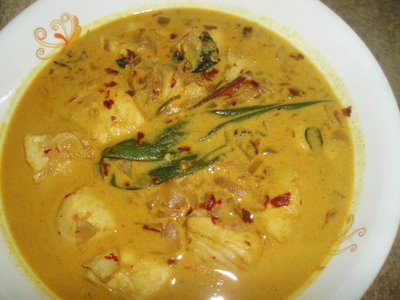
This is one vegetable technology hasn’t improved. I’ve seen vacuum, hand-held, electric – but nothing as effective nor easy to use as the coconut graters of our childhood.
Sit on the floor, rest your knee against the wooden base the lever and grater are affixed to — turn the lever on the right and the rotary grater on the left scoops out the fleshy part of the coconut held over it into zillions of soft, white snowflakes. Even the kattipeeta (the traditional implement used to cut/slice vegetables – usually a curved blade attached to a piece of wood), which ends in a sharp, serrated disc of steel meant for the coconut is not as effective.
That being said, I must say that when Ashwini announced Jihva for Coconut, I had to rack my brains long and hard to come up with an entry. For me, my fascination with coconut lay, and still lies, in the grater I described, the spray of fresh white against newsprint – but apart from the coconut-red chilli-tamarind chutney and kobbari louzu (coconut-jaggery balls) that used to be made at home, I don’t remember other ways we used it, perhaps to thicken a meat gravy? I’m not sure.
When I grew up and got interested in cooking, cookbooks made using coconut an often tiresome and doubt-ridden process. When it had to thicken a curry, the grinder never seemed to do its job properly, at whatever speed, pulse, frappe, whip, beat – the ‘paste’ would end up a loose mix of water, bits of chilli, coconut that refused to grind — and imparted an overwhelmingly coconutty taste to everything it was used in. I don’t think we used coconut milk at home, ever, so which cookbook was right? Squeeze the grated coconut with bare hands, put it in hot water and whiz it in the mixer, thin milk, thick milk, second extract, first extract? So out the coconut went, out of my kitchen and now and then makes an appearance in milk carton form, whence this recipe originates.
Fish curry
Seer fish: ½ a kilo - skinned, boned and cubed
Onions: 3 small, chopped
Thick coconut milk: 1½ cups
Dry red chilli, ground: 6
Pandan leaf: 2
Basil: A little
Cinnamon: 2-inch piece
Curry leaves: A few
Turmeric: A pinch
Fenugreek: ¼ tsp
Ginger-garlic paste: 1 tsp
Limes: 1-2, juiced
Salt: To taste
Put in everything but the limes into a pan and cook till the fish is done. Once it cools, add the lime juice. That’s it, you’re done!
Looks yummy Sra...I have never tried using coconut milk with fish, but now will do so with your recipe.... Thank u..
ReplyDeleteGorgeous!!!
ReplyDeleteThanks so much for your entry Sra. Fish curry is a personal favorite of mine. Our (konkani) curries compulsorily have coconut in them so its good to see a similar yet different take on the dish. Cheers
Beautiful photo and recipe sounds wonderful sra! Great entry for JFI coconut.Don't you wish Jihva had a beautiful logo to display with all these entries?! Hint ;D
ReplyDeleteI am watching all the gals you tagged for responses eagerly!:)) I can't wait until I see some!
Great easy recipe Sra...
ReplyDeleteWhat is Pandan leaves, do they need to be chopped ?
Nice write up about grating the coconut. What you call "kattipeeta" we call "boti" and stiil have one at home in india
Good entry for Jhiva coconut.I love the recipe.Thanks for sharing Sra
ReplyDeletelooks so good, sra.. all i need is some rice now! I still use coconut every single day in my veggies, curries, and rice.. hi hi i have a sum eet 3 jar mixie from the indian street in NJ.Get that ,..its a wonderful investment.
ReplyDeleteHi Chandrika, thanks for stopping by. It's quite a nice combination, I've used it now and then.
ReplyDeleteAshwini, thanks for the compliments.
Asha, thanks. as always, am thrilled you think the photo looks nice, I was wondering if it was too in-your-face. As for the meme, I'm waiting too!
Sandeepa, thanks, I enjoyed writing it. I know the Bengali word, only, I thought it was 'bonti'. Pandan leaves - you'll probably find them in Malaysian/South-East Asian grocery stores. Or in Sri Lankan stores, you can ask for Rampa. They add a lot of fragrance, I've never chopped them. I have an old post called Pandan prawns which has a link to some site which explains pandan, check it out.
Meena, thank you.
Shaheen, actually, i suspect the problem is not with the grinder but with me :) - i've used three mixers in my cooking life, not once was I successful. And we don't have much of a tradition of cooking with coconut, so I don't really miss it much, except for the chutney I mentioned.
sra
ReplyDeleteGreat entry for JFI!
You have a beautiful blog with lots of new recipes! Veg haleem is on my must try list.
Looks delicious Sra !
ReplyDeleteWhat is pandan leaf and were can we get it ?
You are right IT IS "bo(n)ti". Diddn't write that because thought you might get confused with the pronounciation :)
ReplyDeleteDidn't realize you know so much of Bengali. Now I see in a new light, with a halo and everything :)
Arjuna, thanks for the compliments. veg haleem is eminently trial-worthy.
ReplyDeletePriya, it IS tasty. I grow pandan leaf in a pot, but you can probably get it in Thai/Malay or S-E Asian stores, or in Sri Lankan stores as rampa.
Sandeepa, ha! I surprised you, didn't I? Don't know much Bengali, actually, but have read a bit about Bengali cuisine, the latest being Chitrita's book; her last name (Mukherjee, Banerjee?) and the name of the book elude me just at this moment, but it's a v well written book, v interesting. Thank you for conferring a halo on me, I shall wear it proudly!